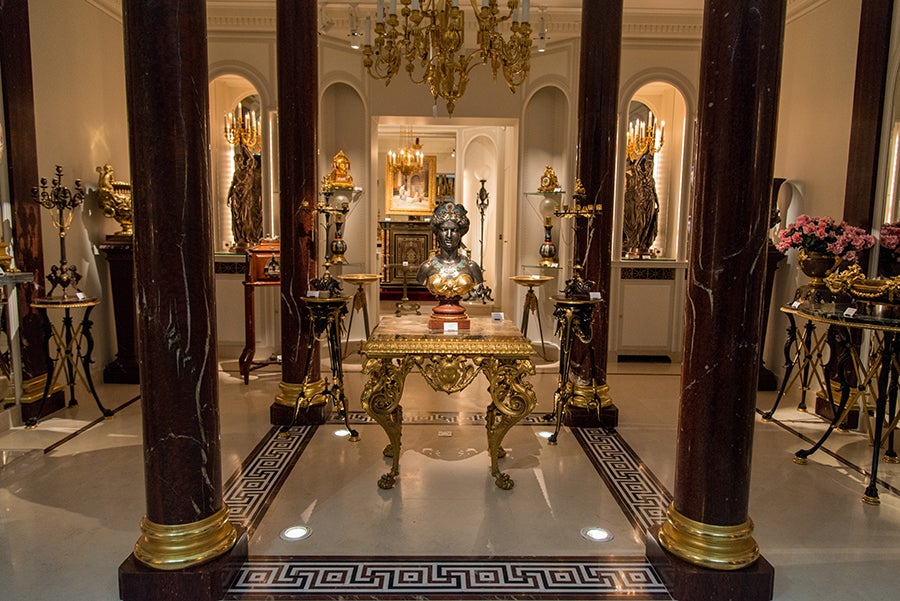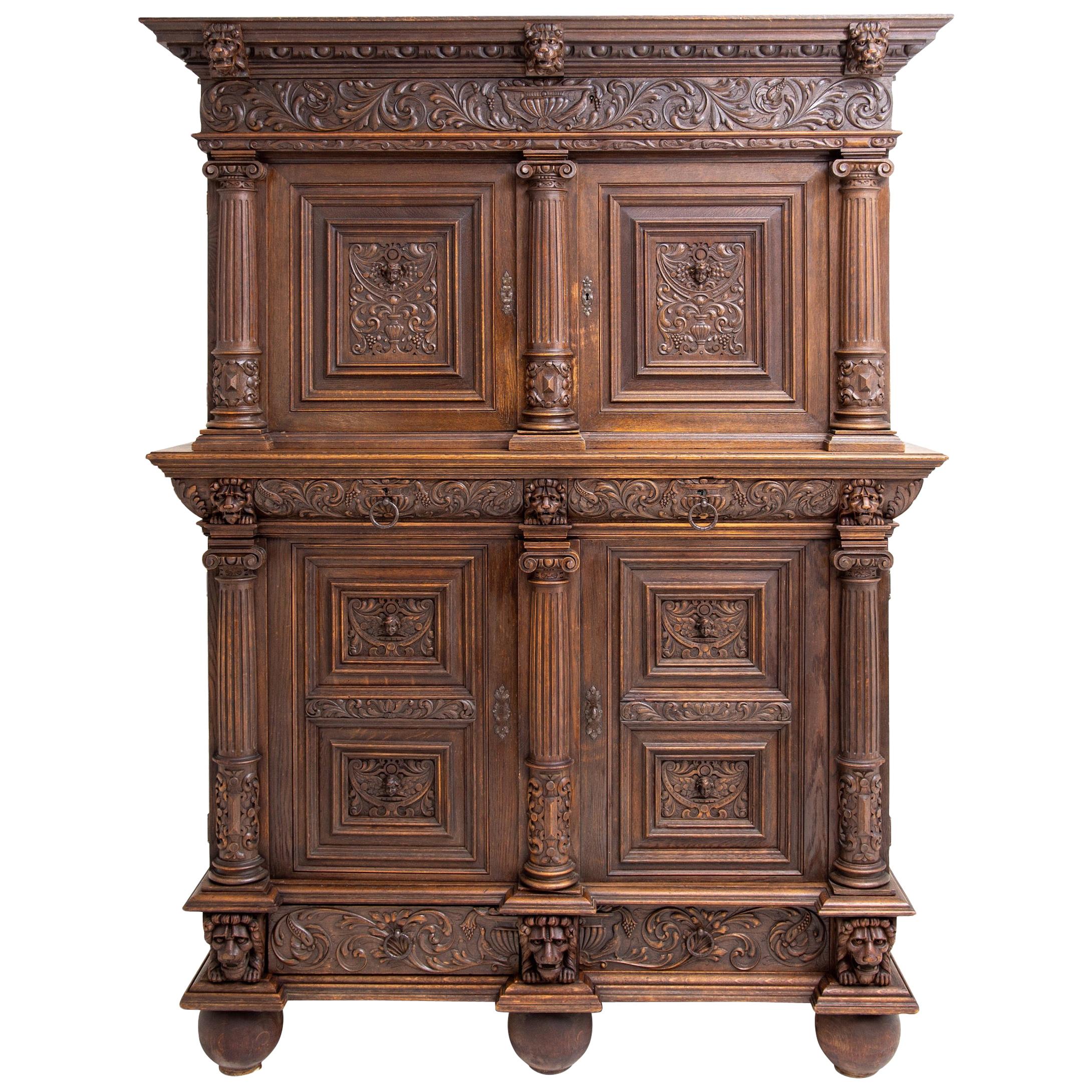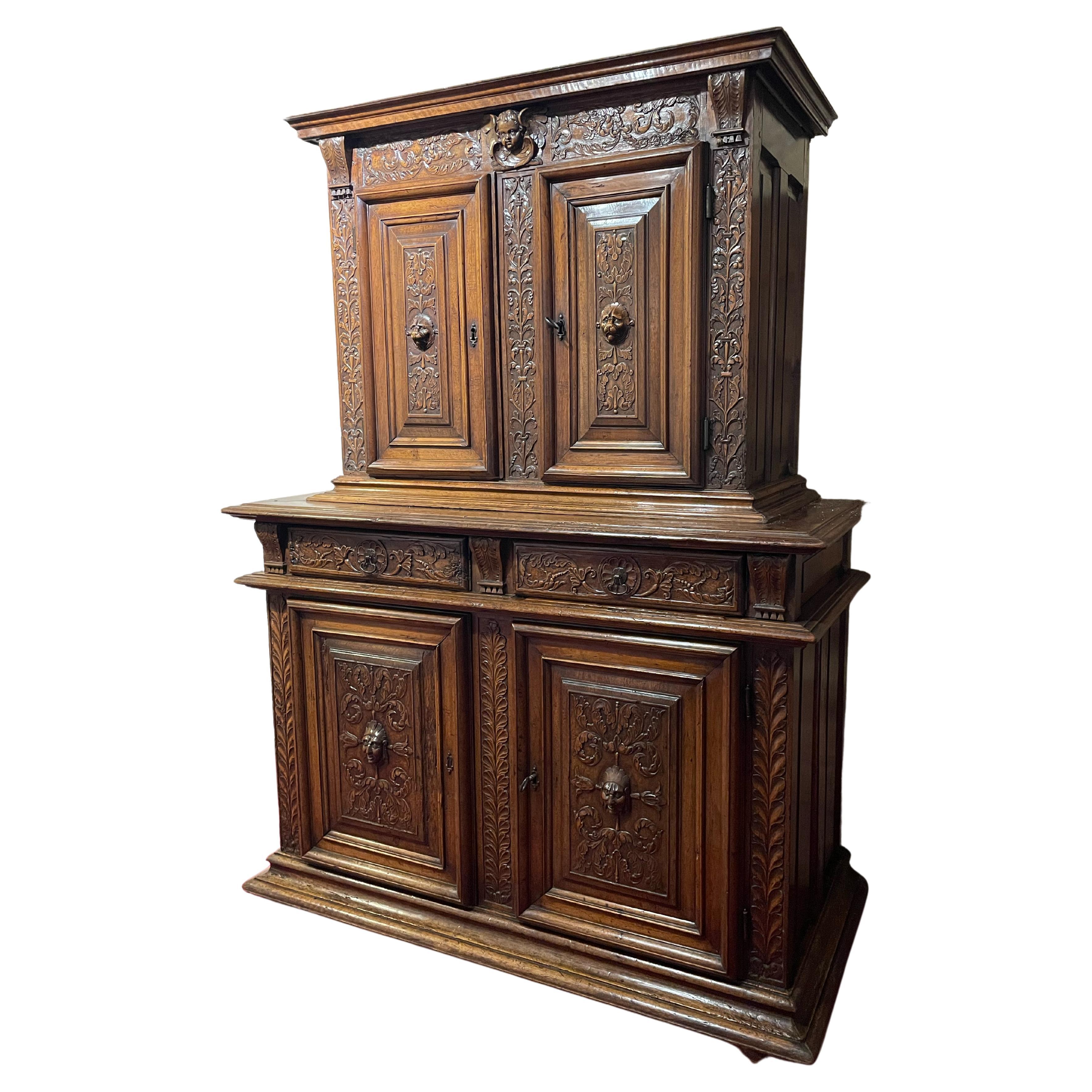Items Similar to Neo-Renaissance Cabinet by G.F. Quignon, Universal Exhibition of Paris 1889
Want more images or videos?
Request additional images or videos from the seller
1 of 21
Neo-Renaissance Cabinet by G.F. Quignon, Universal Exhibition of Paris 1889
About the Item
Presented at the Universal Exhibition of Paris in 1889
Important sculpted and engraved natural wood, patinated bronze and Griotte de Campan red marble inlaid Neo-Renaissance style cabinet.
The upper part is composed of a frieze of bronze medallions separated by triglyphs and supported by ribbed columns with Corinthian capitals. There are eight of these columns paired at the front and two simple columns at the rear. The facade presents an alternation of bronzes in niches and cartouches, of marble slates in cartouches sometimes flanked by palmettes, and of engraved motives of laurel and foliage scrolls. The upper part opens with three leaves and three mobile compartments. The belt carved with acanthus leaves opens with two drawers. This cabinet is supported by four richly sculpted tapered feet ending with claws. Four fluted pilasters are inscribed in the moulded back as counterparts. The whole ensemble stands on a moulded plinth and eight rounded feet.
Neo Renaissance Cabinet exhibited at the Universal Exhibition of Paris in 1889. Illustrated in J. Meyer, Great Exhibitions, London, New York, Paris, Philadelphia, 1851-1900, Antique Collector’s Club, 2006, p. 281. (see picture attached)
Gustave-Frédéric Quignon, born in 1843, worked with his father Napoléon Quignon, boulevard Richard-Lenoir. He took the lead in 1874 and expanded the production of the firm with other seats and pieces of furniture, but also with sculpture. Like his father before him, he produced richly carved and gilded Louis XV and Louis XVI style furniture, but also some Neo-Renaissance furniture. He became a supplier of the Mobilier National. He exhibited at the Universal Exhibition in 1878 and won a gold medal. He was a member of the jury at the Universal Exhibition in 1889. The same year, he relocated the firm rue de Saint-Sabin, where he worked until the end of the century. He participated to the French Exhibition of Moscow in 1891, next to H.Dasson and P.Sormani, and to the rapports sur l’Exposition Internationale de Chigago in 1893. He won the Grand Prix for his stand at the Universal Exhibition of 1900.
- Attributed to:Frederic Gustave Quignon (Cabinetmaker)
- Dimensions:Height: 76.38 in (194 cm)Width: 68.12 in (173 cm)Depth: 22.05 in (56 cm)
- Style:Renaissance (In the Style Of)
- Materials and Techniques:
- Place of Origin:
- Period:
- Date of Manufacture:circa 1889
- Condition:
- Seller Location:PARIS, FR
- Reference Number:

About the Seller
4.9
Vetted Seller
These experienced sellers undergo a comprehensive evaluation by our team of in-house experts.
Established in 1997
1stDibs seller since 2018
73 sales on 1stDibs
Typical response time: <1 hour
Associations
International Confederation of Art and Antique Dealers' Associations
- ShippingRetrieving quote...Ships From: PARIS, France
- Return PolicyA return for this item may be initiated within 7 days of delivery.
More From This SellerView All
- Neo-Renaissance Cabinet by P. Sormani and attr. to E. Lièvre, France, Circa 1870By Paul Sormani, Edouard LievreLocated in PARIS, FRSigned twice on the lock P. SORMANI 10 rue Charlot Paris Rare neo-Renaissance cabinet in carved wood and Portor marble, adorned with chiseled and gilded bronze. The upper, part, surmounted by a frieze of posts and marble cabochons, consists of a central door decorated with a carved panel representing the birth of Venus, framed by two pairs of ringed and fluted columns with Corinthians capitals in gilded bronze revealing two doors with secret opening. Two drawers with lion’s head shaped handles and a central drawer decorated with tracery in gilded bronze complete the upper part of this cabinet. In the lower part, two drawers on the belt with diamond...Category
Antique 1870s French Renaissance Cabinets
MaterialsMarble, Bronze
- Renaissance Style Cabinet, France, Circa 1870Located in PARIS, FRAn outstanding carved cabinet in the Renaissance style. The upper part consists in two stages with arcades, divided in six compartments by rich columns with Corinthian capitals, and topped by a carved entablature. The lower part opens with three doors, ornated with masks, hybrid figures and foliates, and relies on four strong feet. This cabinet, probably executed for an amateur or a collector, is a perfect model for the neo-Renaissance style, that rose in the 1830’s, in France with the designers Claude-Aimé Chenavard (1798-1838) and Michel Liénard (1810-1870). It came some years after the Gothic Revival, but met a longer success during the 19th century (at the Expositions des Produits de l’industrie in 1844 and 1849, and at the Universal Exhibitions in 1855, 1867 and 1878). Inspiration was found in the French Renaissance, more specifically in the art of Henri II’s reign, and cabinet-makers used dark carved...Category
Antique 1870s French Renaissance Cabinets
MaterialsWood
- Renaissance Style Wooden Cabinet Attributed to H.A. Fourdinois, France, 1893Located in PARIS, FRA wooden cupboard, elaborately carved throughout, dated "1893" on the crest and attributed to H.A. Fourdinois. The upper section with a pair of cherubs at the center of a balustrade ornamented with two-handled urns, two architectonic doors below, carved with lady and gentleman in niches surrounded by extensive carving with classical motifs. The lower section with two drawers above a standing female caryatid support at each front corner. The all reposing on four gadronned round feet. The Fourdinois company was founded in 1835 by Alexandre-Georges Fourdinois (1799-1871). The Universal Exhibition held in London in 1851 was undoubtedly their first great artistic and public success. Winning the Great medal for a neo-Renaissance buffet...Category
Antique 1890s French Renaissance Cabinets
MaterialsWood
- Renaissance Style "Four Seasons" Cabinet by M. Lerolle, France, Circa 1890By LerolleLocated in PARIS, FRSigned " Meubles D’Art, M. Lerolle, Fabricant, 61, Rue des Sts-Peres. Paris " Remarkable carved wood cabinet, richly sculpted in the Neo-Renaissance style, and inlaid with vert de m...Category
Antique 1890s French Renaissance Revival Cabinets
MaterialsMarble
- Louis XVI Style Cabinet and its Companion Vitrine by F.Linke, France, Circa 1890By François LinkeLocated in PARIS, FRExceptional Louis XVI style cabinet and its companion vitrine beautifully mounted with chiseled and gilded bronze. They are surmounted by a rectangular top with an egg-and-dart molded edge, above a frieze centered by a laurel-festooned Bacchic mask and scrolling acanthus. The vitrine and the cabinet open by one door ; the paneled door of the cabinet centered by a ribbon-suspended lyre and foliate pendant. Both have the angles adorned with tapering female caryatids, above a guilloche. They rest on tapering fluted quiver-form legs joined by a pierced stretcher, surmounted by a flowery urn, and ending on toupie feet. Related work : Cabinet and vitrine listed under index 684 of Linke’s photographic archives (see photo attached). View of a room of the private collector Elias Meyer’s Mansion, in 16 Grosvenor Square, London, taken in 1909 and reproduced and commented in François Linke (1855-1946), The Belle Epoque of French Furnitures, Ch. Payne, p.247) showing the cabinet and the showcase in situ. (see photo attached). View of the cabinet in situ in the Queen’s bedroom in the Palace Ras al-Tin, in Alexandria, after being bought by King of Egypt Fouad on March 1927. Reproduced and commented in François Linke (1855-1946), The Belle Epoque of French Furnitures, Ch. Payne, p.278. (see photo attached). François Linke, born in 1855 in Bohemia (Czechoslovakia), worked as a cabinet-maker in Paris from about 1882 until his death in 1946. In 1900, at the apex of his career, he opened a new shop at the famous Parisian place Vendôme. He specialized in Louis XV and Louis XVI style furniture: all pieces were beautifully mounted with gilt-bronze ornaments, and he received numerous commissions. Later Linke decided to collaborate with the well-known sculptor Léon Messagé and integrated new lines and shapes announcing the “Art Nouveau” style. His great success is definitely the 1900 Universal Exhibition where he was awarded the gold medal for his extraordinary kingwood desk, designed by Messagé. At this occasion, the “Revue artistique et industrielle” commented that “Linke’s stand...Category
Antique 1890s French Louis XVI Cabinets
MaterialsMarble, Bronze
- Pair of Neo-Renaissance Vitrines, Attributed to H-A Fourdinois, France, c. 1860Located in PARIS, FRFine pair of neo-Renaissance vitrines in richly carved wood, with three glazed sides framed by a relief frieze. Each opening to a drawer decorated with interlacing on the belt, and t...Category
Antique 1860s French Renaissance Revival Vitrines
MaterialsMarble
You May Also Like
- Richly carved Neo-Renaissance solid oak cabinetLocated in STRAČOV, CZRichly carved Neo-Renaissance solid oak cabinet Precise carving work from the 19th century in the Renaissance style. Two-part design where the upper two-door part has internal shelv...Category
Antique 1880s French Renaissance Cabinets
MaterialsOak
- Neo-Renaissance Cabinet, Late 19th CenturyLocated in Greding, DEA four-door cabinet in Renaissance style standing on ball feet with lion's head mascarons and half-columns with volute capitals. The doors with panels and vine decoration are separat...Category
Antique 19th Century German Renaissance Revival Cabinets
MaterialsWood
- 19th Century Neo-Renaissance Cabinet ClosetLocated in Berlin, DE19th century Neo-Renaissance cabinet closet Oak, solid. Richly carved, grotesque carved, two-door cabinet, centered with portrait medallions, resting on a bivouac and on pillars, ...Category
Antique 19th Century German Renaissance Revival Cabinets
MaterialsOak
- Renaissance CabinetLocated in Washington, DCA truly stunning cabinet with a rich patina. Made by a Swedish cabinetmaker in the early 19th century. The paint on the inside and the outside is all original. Original hardware includes the hinges, locks, key, straps. Intricate carved paneling.Category
Antique Early 19th Century Swedish Renaissance Cupboards
MaterialsIron
- Small Renaissance CabinetLocated in Saint-Ouen, FRSmall renaissance cabinet ORIGIN : FRANCE PERIOD : END OF THE 16th CENTURY Measures: height: 167 cm length: 123 cm depth: 58 cm This small two-part unit with harmonious proportions opens with four front leaves and two belt drawers. It rests on a molded base. The uprights and the central frame of the lower body are adorned with long stylized palmettes. They frame the four leaves on which unfolds a vegetal decoration made of stems and leaves sculpted in symmetry around two mascarons topped with feathers...Category
Antique 16th Century French Renaissance Cabinets
MaterialsWalnut
- Neo Renaissance VitrineLocated in Pompano Beach, FLSolid oak, ornately carved. Large glass vitrine with interior shelves above 2 doors with interior shelves. Austro-Hungarian circa 1860/80. Part of ...Category
Antique 19th Century Vitrines
Recently Viewed
View AllMore Ways To Browse
Louis Xvi Style Furniture
Antique Renaissance Furniture
The Great Exhibition Furniture
Exhibition Carved
Antique Round Cabinet
Storage Seat
Exhibition Stand
Antique Exhibition London
Seat With Storage
Cabinet Seat
Exhibit Case
Fluted Wood Cabinet
Bronze Medallion
Antique Cabinet Gold
Wood Patinated Cabinet
Antique Storage Seat
Leaded Cabinet
Antique Cabinet Grand





